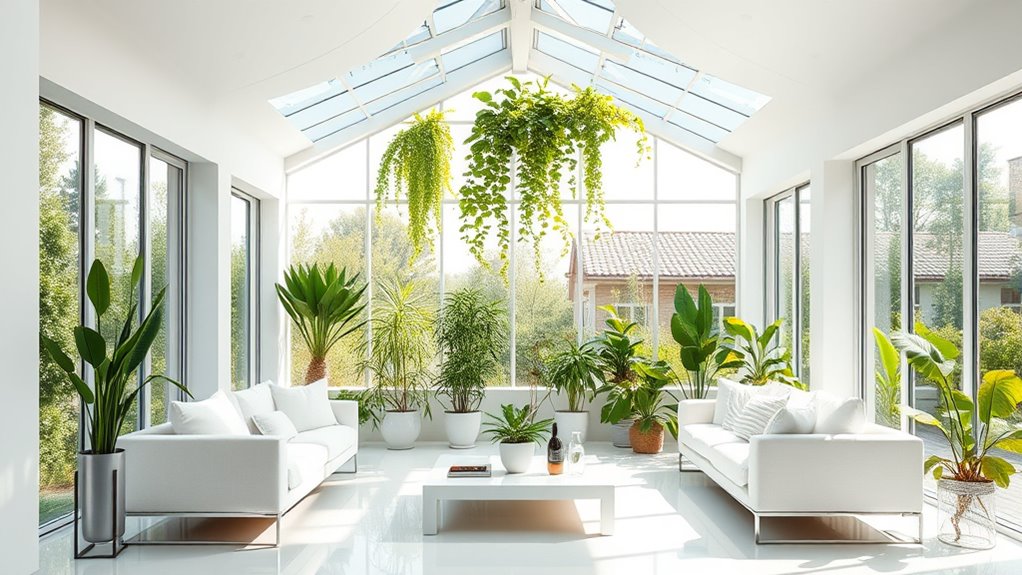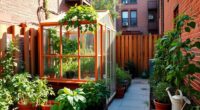By integrating a greenhouse into your minimalist lifestyle, you create a sustainable oasis that promotes self-sufficiency and eco-friendly habits. It allows you to grow fresh produce year-round while minimizing waste and clutter, aligning with your values of simplicity and intentional living. A greenhouse becomes a peaceful space for connection with nature and personal growth, transforming your home into a sanctuary of renewal. Explore how this balance of minimalism and sustainability can enhance your life further.
Key Takeaways
- A greenhouse centralizes sustainable gardening, reducing clutter and promoting eco-friendly living in minimalist homes.
- It extends growing seasons, enabling year-round self-sufficiency with minimal space and maintenance.
- Incorporating a greenhouse aligns with minimalist values of simplicity, self-reliance, and environmental harmony.
- It fosters a connection to natural cycles, encouraging mindful, resource-conscious habits.
- A greenhouse transforms small living areas into productive, meditative sanctuaries that support a sustainable, intentional lifestyle.

Living simply often means finding innovative ways to connect with nature, and a greenhouse can be the perfect addition to a minimalist lifestyle. It offers a practical way to embrace sustainable gardening, allowing you to grow fresh vegetables, herbs, and flowers year-round without relying heavily on store-bought produce. With a greenhouse, you don’t need a sprawling garden or large outdoor space to cultivate your own food; even in an urban setting, it becomes a compact sanctuary for self-sufficiency. This approach aligns perfectly with urban homesteading principles, where maximizing small spaces for productive, sustainable living takes priority. By integrating a greenhouse into your home, you create a dedicated space that minimizes waste, conserves resources, and promotes a more eco-friendly lifestyle.
A greenhouse enables sustainable urban living by growing fresh food year-round in small, eco-friendly spaces.
A greenhouse becomes the heart of your minimalist home, providing a controlled environment that extends your growing season and improves plant health. It encourages a focus on quality over quantity, helping you cultivate a thoughtfully curated garden that reduces your dependence on commercial agriculture. Instead of cluttering your space with unnecessary tools or decorative items, your greenhouse serves a functional purpose—supporting your efforts toward sustainable living. As you tend to your plants, you develop a deeper understanding of the natural cycles and the importance of eco-conscious habits, reinforcing your minimalist values. The simplicity of tending to a greenhouse also means less maintenance and fewer distractions, making it easier to stay aligned with your core principles of intentional living.
Moreover, a greenhouse fosters a sense of independence, empowering you to grow your own food and reduce your carbon footprint. It’s a small step toward creating a more sustainable lifestyle, where each harvest reinforces your commitment to environmental stewardship. Whether you’re growing vegetables, herbs, or even small fruits, you’re actively participating in urban homesteading that prioritizes resourcefulness and resilience. Additionally, some greenhouses incorporate local sourcing principles, connecting you with nearby community resources and reducing reliance on imported produce. The compact nature of a greenhouse means it fits seamlessly into your minimalist home, occupying minimal space while providing maximum benefit. It acts as a mini farm, a place where you can experiment with permaculture ideas or simply enjoy the meditative act of gardening.
In essence, a greenhouse embodies the minimalist ethos—simplicity, self-reliance, and harmony with nature. It isn’t just about growing plants; it’s about creating a sustainable, intentional lifestyle that values quality and connection over excess. With a greenhouse, you turn your living space into a haven of growth and renewal, proving that you don’t need a lot of space to live meaningfully and sustainably.
Frequently Asked Questions
How Much Does Building a Greenhouse Cost?
Building a greenhouse typically costs between $1,000 and $5,000, depending on your choices. You should consider the cost breakdown, including materials like wood, metal, or PVC, and glazing options such as glass or polycarbonate. Your material options will influence the overall price, with DIY setups being more affordable. Budget for foundation work and ventilation as well, ensuring your greenhouse remains functional and cost-effective.
What Climate Zones Are Suitable for Greenhouse Living?
You can enjoy greenhouse living in most climate zones, especially zones where you can adapt the greenhouse to local conditions. Zones with moderate temperatures and adequate sunlight are particularly suitable, as they enhance zone suitability and climate adaptability. In colder zones, you’ll need better insulation and heating, while warmer zones may require shading. Overall, understanding your local climate helps you optimize your greenhouse setup for year-round growth.
How Do I Maintain Energy Efficiency in My Greenhouse?
Your greenhouse can become an energy-saving fortress by using smart insulation techniques like double glazing and thermal curtains. Harness solar heating by positioning your greenhouse to maximize sunlight exposure, especially during winter months. Insulation reduces heat loss like a protective cocoon, while solar heating actively warms your space naturally. Combine these methods to slash energy costs, making your greenhouse a sustainable oasis that stays cozy without draining your wallet.
Can I Grow All Types of Plants in a Greenhouse?
You can grow most types of plants in a greenhouse, but you need to consider plant compatibility and soil requirements. Some plants thrive together, while others may compete for resources. Check each plant’s needs for light, temperature, and soil type to ensure they match your greenhouse environment. By selecting compatible plants and providing appropriate soil conditions, you’ll maximize your greenhouse’s productivity and create a thriving, diverse garden.
What Are the Safety Considerations for Greenhouse Structures?
You need to prioritize structural safety and ventilation requirements when building your greenhouse. Make certain the frame is sturdy, using quality materials that withstand weather conditions, and check for proper anchoring. Adequate ventilation prevents overheating and maintains air circulation, protecting your plants and structure. Regularly inspect for damage, rust, or weak spots, and install vents or fans to promote airflow. These steps help keep your greenhouse safe, functional, and sustainable.
Conclusion
Imagine stepping into your cozy greenhouse, sunlight spilling over your simple, clutter-free space. With each breath, you feel the calm of a minimalist life blending seamlessly with nature’s vibrant greenery. Embracing this lifestyle, you find peace in the beauty of less and the joy of growth—both inside your greenhouse and within yourself. It’s a gentle reminder that true happiness blooms when you keep things simple and nurture your connection to the world around you.









